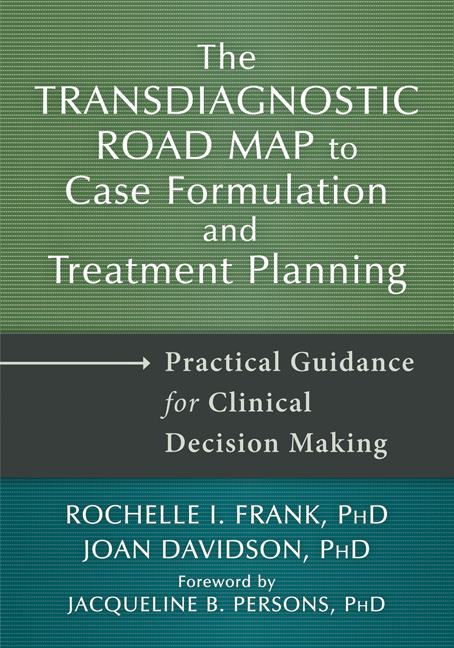by Rochelle I. Frank, PhD, and Joan Davidson, PhD
Transdiagnostic approaches that target underlying psychological processes (rather than symptom constellations) increasingly are becoming the new gold standard of evidence-based treatment. Process-based therapy bridges clinical science and practice, can target a broader range of problems than diagnosis-based protocols, and is more easily individualized and administered to the client. A process-based approach also allow therapists to target multiple problems at once, have a more comprehensive understanding of what limits clients’ functioning and life satisfaction, and to treat problems for which no evidence-based treatment exists. This growing wave of process-based therapy stems from and highlights the limitations of our current classification system, the Diagnostic and Statistical Manual of Mental Disorders, Fifth Edition (DSM-5), which has extensive symptom overlap and takes a mechanistic—rather than humanistic—approach to understanding a client’s problems.
For example, many people who are depressed, anxious, struggle with obsessive-compulsive behaviors, and have executive function deficits and other problems often show up in our offices with symptoms that are hybrids of disorders from the DSM-5 and do not necessarily reflect full-blown disorders. It’s not uncommon to see someone with bipolar depression be impulsive and disorganized and have obsessive thoughts and compulsive behaviors, but not meet criteria for attention deficit hyperactive disorder (ADHD) or obsessive compulsive disorder (OCD). Similarly, a person may report low self-esteem, heightened stress reactions, interpersonal difficulties, and social anxiety, but not have PTSD, borderline personality, or social anxiety disorder.
So how do we go about helping these clients, when the diagnosis isn’t clear and a manualized treatment protocol isn’t available or appropriate? It’s not a matter of stringing together a sequence of protocols, since we know that comorbidities are not simply the sum of singular disorders, and in fact have very varied presentations across individuals—largely because of the underlying transdiagnostic processes (i.e., psychological mechanisms) at play.
Transdiagnostic Mechanisms at Play
Much of the recent research on transdiagnostic mechanisms (e.g., anxiety sensitivity, intolerance of uncertainty, experiential avoidance, rumination) demonstrates how they influence each other and the severity of client problems and functional impairments. Many of these mechanisms are well established as moderators and mediators of anxiety, depression, and post-traumatic stress disorder (PTSD). For example, intolerance of uncertainty correlates with multiple disorders and other mechanisms such as worry in generalized anxiety disorder (GAD), post-event processing in social anxiety, and rumination in depression. Similarly, clients with emotion dysregulation problems (e.g., mood disorders, borderline personality disorder [BPD], PTSD) have distinctive neural deficits that predispose them to avoid emotional experiences, especially if this was modeled for them early in life or if they received messages invalidating their responses.
Consequently, they become less capable of managing emotions and more vulnerable to future dysregulation when faced with additional stressors. These types of feedback loops among transdiagnostic processes may be conceptualized as Vulnerability and Response Mechanisms (Frank & Davidson, 2014). Vulnerability mechanisms include those hard-wired (e.g., anxiety sensitivity) or learned (e.g., metacognitive beliefs) processes that lead to ineffective behavioral responses (e.g., experiential avoidance) that people engage in to try to cope with the resultant distress. Process-based treatment allows therapists to identify mechanisms and how they present in your client, develop a formulation to explain how those mechanisms contribute to presenting problems, and select interventions that target these mechanisms throughout different stages of therapy. But how do we actually accomplish this?
Shop scholarly and reference books
What does process-based treatment look like with a real client?
Let’s look at Sally, who struggles with: (a) chronic depression; (b) obsessive, shame-based self-critical thoughts related to growing up with rigid rules, high expectations, and invalidation of emotional responses; and (c) avoidance of social situations and new experiences. One of the first things to consider is our sense of Sally—how she relates to us in the room, any cultural considerations that will facilitate or impede treatment (e.g., views of therapy, approach to new relationships, educational level, socioeconomic status, compatibility with the therapist [age, gender, race, ethnicity]), strengths, and limitations; these will factor into our approach to developing a solid therapeutic alliance. Our sense of Sally will evolve over time and help us get creative in tailoring interventions to her specific needs, including the use of metaphors, music, film, books, and other media. For example, if Sally is athletic, relating the emotional challenges of doing exposure to physical ones she has overcome playing sports, can motivate her to try this and other potentially difficult interventions.
SEE ALSO: Transdiagnostic Psychology: Why We Need a Transdiagnostic Road Map
Another strategy is observing behaviors that suggest initial mechanism hypotheses, and targeting these early in treatment with interventions that require little client effort and offer big dividends. For example, validating Sally’s current emotional experiences can be paired with compassion-focused interventions to help her overcome early learned responses and negative schemas that feed self-critical thoughts and avoidance of social situations. Creating behavioral experiments wherein Sally can practice bending the rules—and see that expected catastrophic outcomes likely won’t occur—will gradually reshape early messages dissuading her from taking risks and trying new things. Sally will need to build skills in managing distress and regulating emotions so she doesn’t become overwhelmed, give up, and view herself and/or therapy as a failure.
Helping Sally learn to identify uncertainties that prevent her from taking action, and then increasing psychological flexibility and building an exposure hierarchy that will gradually teach her that she can indeed cope with uncertainty (especially if she is able to use skills to manage her emotions and distress around it), will reduce avoidance behaviors around new experiences. Given Sally’s chronic depression, we would also discuss the possibility of medications with her and refer her for a psychiatric consultation. Behavioral activation can be introduced to increase Sally’s pleasurable experiences and develop/enhance a sense of mastery, which will improve her mood.
These are just a few examples of how to select interventions that target the psychological processes driving Sally’s problems. Depending on your training and expertise, other equally effective strategies could be selected. Decisions about these interventions, weighing pros and cons of getting better, brainstorming obstacles to progress, and assessing how Sally is responding to the interventions, is an ongoing collaborative process between clinician and client that allows us to adjust the formulation and treatment plan as new mechanism hypotheses are developed, interventions are tried, and goals are reached.
By focusing on psychological processes rather than their phenotypic symptoms, we can achieve wider-reaching therapeutic change and help clients develop greater resilience to future stressors. Thus, it is not surprising that the research community also has prioritized the study of transdiagnostic mechanisms, more and more graduate training programs are incorporating transdiagnostic therapy approaches into their didactic and clinical curricula, and professional conferences are adopting them as the main focus of continuing education for mental health professionals. These developments clearly mark a new era of psychology from diagnosis-based treatment to process-based treatment.
 Rochelle I. Frank, PhD, is a clinical psychologist in Oakland, CA, and an assistant clinical professor of psychology in the Clinical Science Program at the University of California, Berkeley. She has over twenty-five years of experience in outpatient, inpatient, and residential settings, and specializes in the treatment of complex and co-occurring psychological problems, including bipolar and other mood disorders, trauma and dissociative disorders, and borderline personality. She is co-author of The Transdiagnostic Road Map to Case Formulation and Treatment Planning.
Rochelle I. Frank, PhD, is a clinical psychologist in Oakland, CA, and an assistant clinical professor of psychology in the Clinical Science Program at the University of California, Berkeley. She has over twenty-five years of experience in outpatient, inpatient, and residential settings, and specializes in the treatment of complex and co-occurring psychological problems, including bipolar and other mood disorders, trauma and dissociative disorders, and borderline personality. She is co-author of The Transdiagnostic Road Map to Case Formulation and Treatment Planning.
Joan Davidson, Ph.D., is Co-Director and a Founding Partner of the San Francisco Bay Area Center for Cognitive Therapy and Assistant Clinical Professor in the Clinical Science Program at the University of California, Berkeley. She specializes in the treatment of adults with mood and anxiety disorders and is co-author of The Transdiagnostic Road Map to Case Formulation and Treatment Planning: Practical Guidance for Clinical Decision Making.



 2024 Peace Playbook: 3 Tactics to Avoid Clashes with Your Partner
2024 Peace Playbook: 3 Tactics to Avoid Clashes with Your Partner